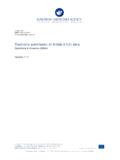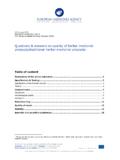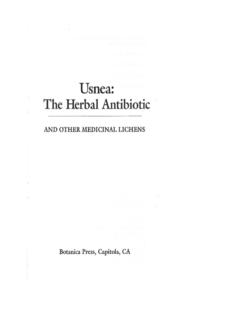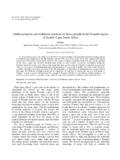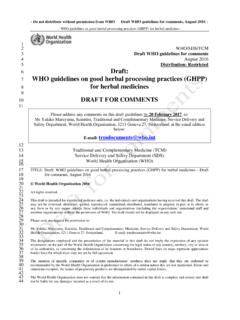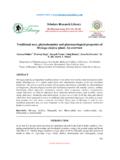Transcription of products1/traditional herbal medicinal products
1 31 March 2011. EMA/CPMP/QWP/2819/00 Rev. 2. EMA/CVMP/814/00 Rev. 2. EMA/HMPC/201116/2005 Rev. 2. Committee for medicinal products for Human Use (CHMP). Committee for medicinal products for Veterinary Use (CVMP). Committee on herbal medicinal products (HMPC). Guideline on quality of herbal medicinal products 1 / traditional herbal medicinal products Final Discussion at the HMPC January July 2005. Draft agreed by Quality Working Party June 2005. Adoption by CHMP for release for consultation 27 July 2005. Adoption by CVMP for release for consultation 13 July 2005. End of consultation (deadline for comments) 30 September 2005. Discussion at the HMPC November 2005 January 2006. Adoption by the HMPC 22 January 2006. Agreed by Quality Working Party February 2006. Adoption by CHMP 23 March 2006. Adoption by CVMP 16 March 2006. Date for coming into effect 1 October 2006. Revision by HMPC Quality Drafting Group February 2011.
2 April 2011. Adoption by the HMPC 31 March 2011. Adoption by CHMP 12 September 2011. Adoption by CVMP 14 September 2011. 1. Throughout the guideline and unless otherwise specified, the term herbal medicinal product includes traditional herbal medicinal product . 7 Westferry Circus Canary Wharf London E14 4HB United Kingdom Telephone +44 (0)20 7418 8400 Facsimile +44 (0)20 7523 7455. E-mail Website An agency of the European Union European Medicines Agency, 2011. Reproduction is authorised provided the source is acknowledged. Explanatory note: This guideline updates the CPMP/CVMP/QWP Guideline on quality of herbal medicinal products '. Further to the adoption of Directive 2004/24/EC for traditional herbal medicinal products for human use, the guideline was updated to take account of the newly introduced definitions and responsibilities. In addition, other clarifications and corrections to the existing text were introduced.
3 There is no expectation that existing herbal medicinal products on the market will be affected by this guideline, with the exception of traditional herbal medicinal products for human use that were already on the market on the entry into force of Directive 2004/24/EC (30 April 2004) for which the competent authorities shall apply the provisions of Directive 2004/24/EC within seven years of its entry into force. For any new marketing authorisation application, this guideline is applicable. This guideline is also applicable to any traditional use (human) registration application submitted after 30 October 2005, by when Member States shall comply with Directive 2004/24/EC. Explanatory note on revision 2: Minor corrections updating the CPMP/CVMP/QWP Guideline on quality of herbal medicinal products ' were introduced, which take into account new and revised guidelines, the European Pharmacopoeia revised general monograph Herbals Drugs', as well as new requirements for impurities.
4 Given the nature of this update, a concept paper or public consultation was not required. Guideline on quality of herbal medicinal productsF F/ traditional herbal medicinal products EMA/CPMP/QWP/2819/00 Rev. 2 Page 2/13. EMA/CVMP/814/00 Rev. 2. EMA/HMPC/201116/2005 Rev. 2. Guideline on quality of herbal medicinal products / traditional herbal medicinal products Table of contents 1. Introduction .. 4. 2. Scope .. 4. 3. Qualitative and quantitative particulars of the active substance(s) of a herbal medicinal 4. herbal substances and herbal preparations consisting of comminuted or powdered herbal substances ..5. herbal preparations produced by steps, which exceed comminution ..6. Active substance .. 6. 4. Description of the method of preparation of the herbal medicinal product .. 8. 5. Control of starting materials .. 8. Control of herbal substances and of herbal preparations ..8. Control of vitamins and minerals (if applicable).
5 10. Control of excipients .. 10. 6. Control tests carried out at an intermediate stage of the manufacturing process of the herbal medicinal 10. 7. Control tests on the herbal medicinal 10. 8. Stability tests .. 11. 9. 12. Guideline on quality of herbal medicinal products / traditional herbal medicinal products EMA/CPMP/QWP/2819/00 Rev. 2 Page 3/13. EMA/CVMP/814/00 Rev. 2. EMA/HMPC/201116/2005 Rev. 2. 1. Introduction This guideline concerns the application of Module 3 of Annex I to Directive 2001/83/EC as amended for human herbal medicinal products and Part 2 of Annex I to Directive 2001/82/EC as amended for veterinary herbal medicinal products . The special problems of herbal medicinal products and the differences between medicinal products containing chemically defined active substances are described in this document. It should be read in conjunction with the Guideline on specifications: test procedures and acceptance criteria for herbal substances, herbal preparations and herbal medicinal products / traditional herbal medicinal products ' (EMEA/CPMP/QWP/2820/00 and EMEA/CVMP/815/00.)
6 As revised). A simplified registration procedure was established for traditional herbal medicinal products for human use under Directive 2004/24/EC. The quality of a herbal medicinal product is independent of its traditional use, therefore all general principles of quality also apply to traditional herbal medicinal products for human use. traditional herbal medicinal products for human use may additionally contain vitamins or minerals. Concerning these products , this guideline describes specific aspects linked to mixtures of herbal substances/preparations with vitamins and/or minerals. In addition, the quality, specifications and documentation for each vitamin and mineral have to comply with all relevant legislation and guidelines. Applications should be submitted in the format referred to in the relevant Notice to Applicants, in the relevant volumes of the Rules Governing medicinal products in the European Union and the Guideline on the use of the CTD format in the preparation of a registration application for traditional herbal medicinal products ' (EMEA/HMPC/71049/2007).
7 2. Scope This guideline intends to cover the general quality aspects of herbal medicinal products (for human and veterinary use), including traditional herbal medicinal products for human use. products containing chemically defined isolated constituents or a mixture thereof are not herbal medicinal products . The guideline should also be read in conjunction with Annex 7 Manufacture of herbal medicinal products of Good Manufacturing Practice (GMP) for medicinal products , Volume 4, Rules Governing medicinal products in the European Union; GMP recommendations should be respected. Consistent quality for products of herbal origin can only be assured if the starting materials are defined in a rigorous and detailed manner, particularly the specific botanical identification of the plant material used. It is also important to know the geographical source and the conditions under which the herbal substance is obtained to ensure material of consistent quality.
8 The Guideline on Good Agricultural and Collection Practice for Starting Materials of herbal Origin (GACP)'. (EMEA/HMPC/246816/2005) should also be considered. 3. Qualitative and quantitative particulars of the active substance(s) of a herbal medicinal product All herbal substances/ herbal preparations are essentially defined by their production process and their specifications. Guideline on quality of herbal medicinal products / traditional herbal medicinal products EMA/CPMP/QWP/2819/00 Rev. 2 Page 4/13. EMA/CVMP/814/00 Rev. 2. EMA/HMPC/201116/2005 Rev. 2. Standardised herbal substances/ herbal preparations are adjusted to a given content of constituents with known therapeutic activity within an acceptable tolerance; standardisation is achieved by adjustment of the herbal substances/ herbal preparations with excipients or by blending batches of herbal substances and/or herbal preparations. Quantified herbal substances/ herbal preparations are adjusted to a defined range of constituents (active markers); adjustment is exclusively achieved by blending batches of herbal substances and/or herbal preparations.
9 Other herbal substances/ herbal preparations are active substances for which neither constituents with known therapeutic activity nor active markers are known. These herbal substances/ herbal preparations are not adjusted to a defined content of analytical marker. In cases where excipients for the manufacture of active substances are used ( for technological reasons or for adjustment of standardised herbal substances/preparations), the name and the quantity of these excipients have to be stated. herbal substances and herbal preparations consisting of comminuted or powdered herbal substances For herbal substances and herbal preparations consisting of comminuted or powdered herbal substances the grade of comminution has to be given. Furthermore the following has to be indicated: (i) in the case of standardisation: the quantity of the herbal substance/preparation shall be given as a range corresponding to a defined quantity of constituents with known therapeutic activity.
10 (iia) in the case of quantification: the quantity of the herbal substance/preparation shall be stated as a distinct content and the content of the quantified substance(s) shall be specified in a range. (iib) for all other cases: the quantity of the herbal substance or the quantity of the genuine herbal preparation shall be stated as a distinct content. Examples i) Active substance Name Quantity Sennae folium 415-500 mg, corresponding to mg of hydroxyanthracene glycosides, calculated as sennoside B. iia) Active substance Name Quantity Salicis cortex 4 g, corresponding to 40 to 48 mg of total phenolic glycosides, expressed as salicin iib) Active substance Name Quantity Valerianae radix 900 mg Guideline on quality of herbal medicinal products / traditional herbal medicinal products EMA/CPMP/QWP/2819/00 Rev. 2 Page 5/13. EMA/CVMP/814/00 Rev. 2. EMA/HMPC/201116/2005 Rev. 2. herbal preparations produced by steps, which exceed comminution In the case of a herbal preparation produced by steps which exceed comminution, the nature and concentration of the solvent and the physical state of the extract have to be given.
